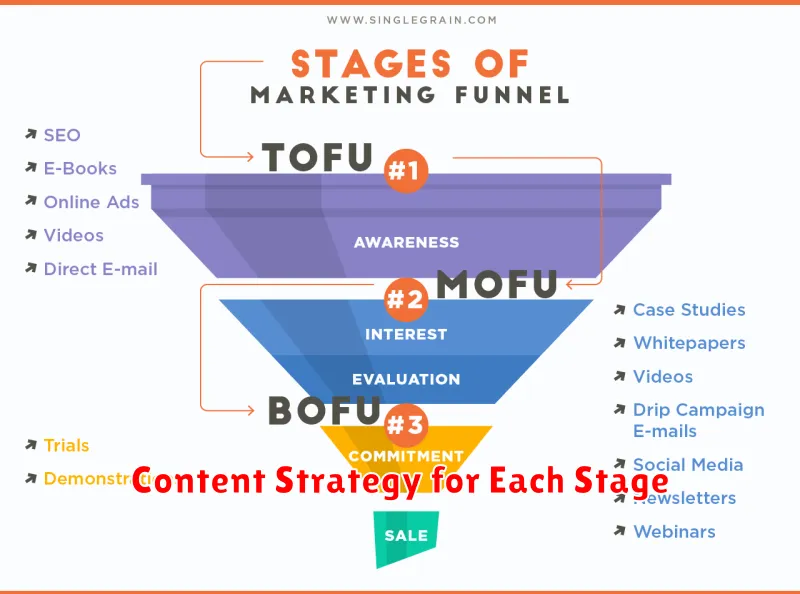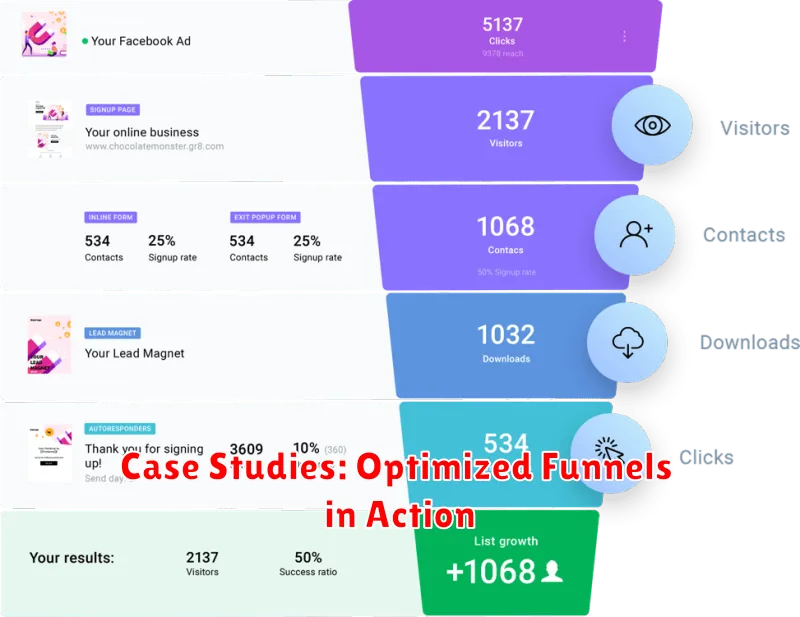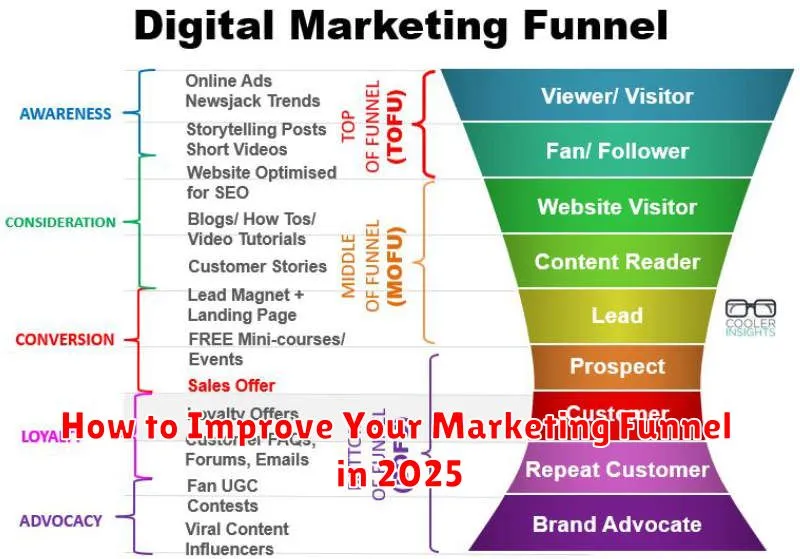In today’s rapidly evolving digital landscape, a high-performing marketing funnel is more critical than ever. Staying ahead of the curve in 2025 requires a deep understanding of how to optimize each stage of your funnel, from attracting leads to converting customers and fostering long-term loyalty. This article will explore proven strategies and cutting-edge tactics to help you improve your marketing funnel and achieve significant growth in the coming year. We’ll delve into the key elements of a successful marketing funnel strategy, including lead generation, nurturing, qualification, and conversion optimization, providing you with actionable insights to enhance your overall marketing performance.
Whether you’re a seasoned marketer looking to refine your approach or a newcomer seeking to build a robust marketing funnel from the ground up, this guide offers valuable information to help you succeed. We’ll cover topics such as personalization, automation, data analysis, and customer journey mapping, all essential components of a modern marketing funnel. Learn how to improve your marketing funnel in 2025 and drive substantial business results by implementing the techniques and best practices outlined in this comprehensive article. Discover how to maximize conversions, boost customer lifetime value, and ultimately, achieve a higher return on investment (ROI) for your marketing efforts.
What Is a Marketing Funnel?
A marketing funnel is a visual representation of the customer journey, from initial awareness of a product or service to the final purchase decision. It describes the process businesses use to guide potential customers toward conversion. The funnel shape illustrates how a large number of potential customers enter the top of the funnel, but only a smaller percentage progress through each stage to ultimately become paying customers. The key stages of a marketing funnel are typically awareness, interest, consideration, and action.
At the awareness stage, potential customers become aware of your brand or product, perhaps through advertising, social media, or word of mouth. The interest stage sees them learning more and engaging with your content. During consideration, potential customers evaluate your product or service against competitors and research their options. Finally, the action stage is where a purchase is made, a subscription is started, or another desired outcome is achieved.
Understanding the marketing funnel allows businesses to target their marketing efforts more effectively. By analyzing customer behavior at each stage, they can tailor content and messaging to address specific needs and concerns. This strategic approach optimizes resources and improves conversion rates.
Stages: Awareness, Interest, Desire, Action
The AIDA model represents a classic marketing funnel illustrating the customer journey toward a purchase. Awareness is the first stage, where potential customers become aware of a product or service. This can be achieved through various marketing channels like advertising, public relations, or social media. A successful awareness campaign ensures the target audience knows the brand or product exists.
Once awareness is established, interest must be piqued. This stage involves providing engaging and relevant content that captures the audience’s attention and encourages them to learn more. This could include highlighting key features and benefits, demonstrating value, and addressing potential customer needs or pain points. Generating interest is crucial for moving potential customers further down the funnel.
Desire follows interest, representing the stage where the customer develops a positive emotional connection with the product or service. Marketing efforts at this stage should focus on building a strong brand image, emphasizing the product’s unique selling propositions, and showcasing positive customer testimonials or reviews. Finally, the action stage signifies the desired outcome: the customer makes a purchase or takes another desired action, such as signing up for a newsletter or requesting a demo. Effective calls to action and a seamless purchasing process are vital for converting desire into action.
Identifying Funnel Leaks
A sales funnel represents the journey a customer takes from initial awareness to final purchase. Identifying leaks in this funnel is crucial for maximizing conversions and revenue. A leak occurs when potential customers drop off at any stage of the process, indicating a friction point that needs addressing. Analyzing each stage for drop-off rates is the first step in identifying these leaks.
Several key metrics can help pinpoint these problem areas. Monitoring metrics such as cart abandonment rates, click-through rates (CTR) on calls to action, and conversion rates at each stage provides valuable insights. Comparing these metrics against industry benchmarks or past performance can further highlight areas of underperformance and potential leaks.
Once identified, addressing these leaks requires careful analysis and strategic adjustments. This may involve simplifying the checkout process, improving website navigation, refining marketing messaging, or offering targeted incentives. Continuous monitoring and optimization are essential to ensuring a healthy and high-converting sales funnel.
Content Strategy for Each Stage

Awareness Stage: Focus on educating potential customers about the problem your product or service solves. Content should be informative and engaging, addressing common questions and pain points. This stage prioritizes building brand recognition and establishing your expertise.
Consideration Stage: Now that prospects understand the problem, showcase your solution. Highlight the benefits and features of your product/service, demonstrating its value proposition. Content formats like case studies, comparisons, and webinars are effective here.
Decision Stage: Help potential customers make the final purchasing decision. Focus on building trust and reducing perceived risks. Offer free trials, demos, testimonials, and strong guarantees to solidify their confidence in your offering.
Aligning Sales and Marketing Efforts
Aligning sales and marketing is crucial for business growth. When these two departments work in sync, they create a unified front that attracts, nurtures, and converts leads into customers. Misalignment, however, can lead to wasted resources, missed opportunities, and internal conflict. A key component of alignment is establishing shared goals and clear communication. This ensures both teams are working towards the same objectives and understand their respective roles in the customer journey.
Open communication and regular feedback loops are essential. Teams should share data, insights, and best practices to ensure everyone is on the same page. Sales can provide valuable feedback on marketing campaigns, while marketing can equip sales with the right tools and resources to effectively engage prospects. This collaborative approach fosters a stronger understanding of the target audience and helps refine strategies to improve overall performance.
Ultimately, sales and marketing alignment aims to create a seamless and positive customer experience. By working together, these teams can ensure consistent messaging, personalized outreach, and a streamlined buying process. This cohesive approach strengthens brand perception, builds customer loyalty, and drives revenue growth.
Using Retargeting to Re-Engage
Retargeting is a powerful digital marketing strategy that allows you to reconnect with website visitors who have shown interest in your products or services but didn’t complete a desired action, such as making a purchase or filling out a form. By displaying targeted ads to these individuals as they browse other websites, you can effectively remind them of your brand and encourage them to return and convert.
Retargeting campaigns are typically implemented using cookies, which track user behavior on your website. This data allows you to segment your audience and tailor your ads to their specific interests. For example, if someone viewed a specific product page, you can retarget them with ads featuring that same product or similar items. This personalized approach is much more effective than generic advertising and leads to higher click-through and conversion rates.
The benefits of retargeting are numerous. It increases brand awareness, improves conversion rates, and maximizes your return on ad spend (ROAS). By strategically re-engaging potential customers, you can effectively move them down the sales funnel and turn interested browsers into paying customers.
Conversion Rate Optimization Tips
Conversion Rate Optimization (CRO) is the process of increasing the percentage of website visitors who complete a desired action, such as making a purchase or filling out a form. Focusing on CRO is crucial for maximizing the return on investment from your website traffic. By understanding user behavior and implementing strategic changes, you can significantly improve your bottom line.
Key areas to focus on include A/B testing different versions of web pages, improving website navigation and usability, and creating compelling calls to action. Consider using heatmaps and analytics to understand how users interact with your site and identify areas for improvement. Even small changes, like button color or text adjustments, can have a substantial impact on conversions.
To further enhance your CRO efforts, focus on building trust and credibility. Showcase customer testimonials, security badges, and guarantees to reassure potential customers. Additionally, personalize the user experience wherever possible. By tailoring content and offers to specific user segments, you can create a more engaging and effective website.
Funnel Tools and Automation
Funnel tools streamline the process of guiding potential customers through the sales journey. These tools help businesses create targeted campaigns, capture leads, nurture prospects, and ultimately convert them into paying customers. They often include features for landing page creation, email marketing, automated workflows, and analytics tracking, all designed to optimize each stage of the sales funnel.
Automation plays a crucial role in maximizing the effectiveness of funnel tools. By automating repetitive tasks such as email sequences, follow-ups, and social media postings, businesses can free up time and resources to focus on other important aspects of their operations. Automation also ensures consistent messaging and personalized experiences for prospects, leading to improved conversion rates.
Selecting the right tools and automation strategies depends on specific business needs and target audience. Key considerations include the complexity of the sales funnel, budget, technical expertise, and integration with existing systems. Choosing wisely can significantly impact the success of a business’s marketing and sales efforts.
Analyzing Funnel Performance
Analyzing funnel performance is crucial for understanding where users drop off in a conversion process. A funnel visually represents the steps a user takes, from initial awareness to the desired action (e.g., purchase, sign-up). By examining each stage, businesses can pinpoint bottlenecks and areas for improvement. Key metrics to track include conversion rates, drop-off rates, and time spent at each stage. This data helps identify friction points impacting user experience and hindering conversions.
Common reasons for poor funnel performance include a complex or confusing checkout process, technical issues, slow loading times, and a lack of clear calls to action. Addressing these issues through A/B testing, streamlining forms, and improving website performance can significantly enhance conversion rates. Regularly analyzing funnel performance allows for iterative improvements and optimization, ensuring that the user journey is as smooth and engaging as possible.
Effective funnel analysis goes beyond identifying problems. It provides actionable insights to optimize the user experience, ultimately driving business growth. By understanding user behavior at each stage, companies can personalize messaging, refine targeting, and implement strategies to maximize conversion rates and achieve business objectives. This data-driven approach is essential for long-term success.
Case Studies: Optimized Funnels in Action

Case Study 1: E-commerce Retailer – An e-commerce retailer specializing in handmade goods saw a significant drop in cart abandonment rates after implementing a streamlined checkout process. By reducing the number of steps required to complete a purchase and offering multiple payment options, they increased conversions by 15% within the first quarter. This optimization focused on simplifying the user experience within the funnel, removing friction points, and ultimately leading to a more profitable outcome.
Case Study 2: SaaS Company – A software-as-a-service (SaaS) company offering project management software struggled with converting trial users into paying customers. By implementing a targeted email sequence that provided valuable tips and resources during the trial period, they nurtured leads and showcased the software’s key benefits. This resulted in a 20% increase in trial-to-paid conversions. The key to this success was personalized communication and demonstrating value throughout the user journey.
Case Study 3: Lead Generation Agency – A lead generation agency focusing on the real estate sector saw a substantial improvement in lead quality after optimizing their landing page. By clearly defining the target audience and tailoring the page content to address their specific needs and pain points, they increased qualified leads by 25%. This optimization emphasized the importance of relevance and targeted messaging in attracting the right leads.

